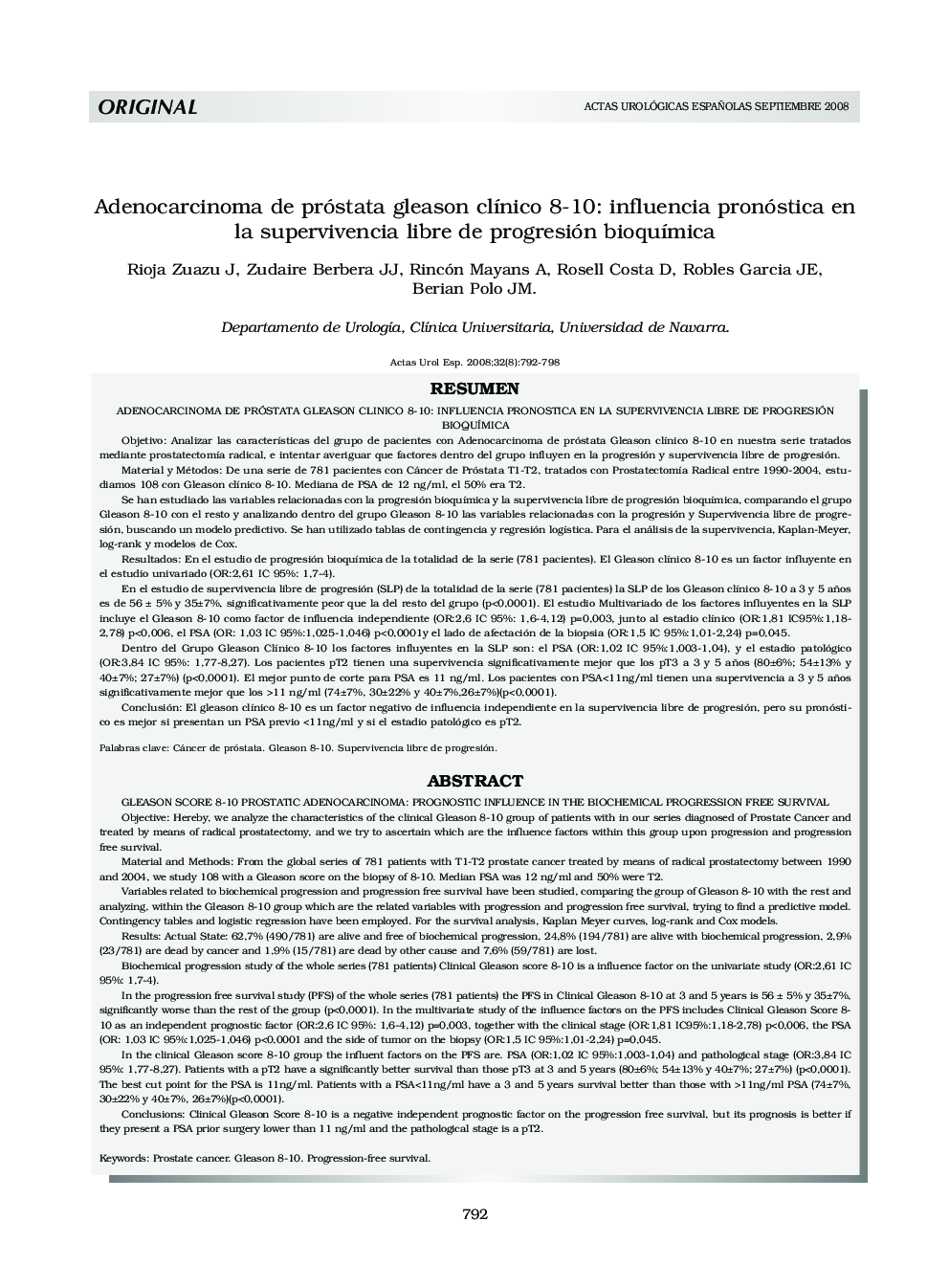| Article ID | Journal | Published Year | Pages | File Type |
|---|---|---|---|---|
| 3844438 | Actas Urológicas Españolas | 2008 | 7 Pages |
ResumenAdenocarcinoma de próstata gleason clinico 8-10: influencia pronostica en la supervivencia libre de progresión bioquimicaObjetivoAnalizar las características del grupo de pacientes con Adenocarcinoma de próstata Gleason clínico 8-10 en nuestra serie tratados mediante prostatectomía radical, e intentar averiguar que factores dentro del grupo influyen en la progresión y supervivencia libre de progresiónMaterial y MétodosDe una serie de 781 pacientes con Cáncer de Próstata T1-T2, tratados con Prostatectomía Radical entre 1990-2004, estudiamos 108 con Gleason clínico 8-10. Mediana de PSA de 12 ng/ml, el 50% era T2Se han estudiado las variables relacionadas con la progresión bioquímica y la supervivencia libre de progresión bioquímica, comparando el grupo Gleason 8-10 con el resto y analizando dentro del grupo Gleason 8-10 las variables relacionadas con la progresión y Supervivencia libre de progresión, buscando un modelo predictivo. Se han utilizado tablas de contingencia y regresión logistica. Para el análisis de la supervivencia, Kaplan-Meyer, log-rank y modelos de CoxResultadosEn el estudio de progresión bioquímica de la totalidad de la serie (781 pacientes). El Gleason clínico 8-10 es un factor influyente en el estudio univariado (OR:2,61 IC 95%: 1,7-4)En el estudio de supervivencia libre de progresión (SLP) de la totalidad de la serie (781 pacientes) la SLP de los Gleason clinico 8-10 a 3 y 5 años es de 56 ± 5% y 35±7%, significativamente peor que la del resto del grupo (p<0,0001). El estudio Multivariado de los factores influyentes en la SLP incluye el Gleason 8-10 como factor de influencia independiente (OR:2,6 IC 95%: 1,6-4,12) p=0,003, junto al estadio clínico (OR:1,81 IC95%:1,18-2,78) p<0,006, el PSA (OR: 1,03 IC 95%:1,025-1,046) p<0,0001y el lado de afectación de la biopsia (OR:1,5 IC 95%:1,01-2,24) p=0,045Dentro del Grupo Gleason Clínico 8-10 los factores influyentes en la SLP son: el PSA (OR:1,02 IC 95%:1,003-1,04), y el estadio patológico (OR:3,84 IC 95%: 1,77-8,27). Los pacientes pT2 tienen una supervivencia significativamente mejor que los pT3 a 3 y 5 años (80±6%; 54±13% y 40±7%; 27±7%) (p<0,0001). El mejor punto de corte para PSA es 11 ng/ml. Los pacientes con PSA<11ng/ml tienen una supervivencia a 3 y 5 años significativamente mejor que los >11 ng/ml (74±7%, 30±22% y 40±7%,26±7%)(p<0,0001)ConclusiónEl gleason clínico 8-10 es un factor negativo de influencia independiente en la supervivencia libre de progresión, pero su pronostico es mejor si presentan un PSA previo <11ng/ml y si el estadio patológico es pT2
Gleason score 8-10 prostatic adenocarcinoma: prognostic influence in the biochemical progression free survivalObjectiveHereby, we analyze the characteristics of the clinical Gleason 8-10 group of patients with in our series diagnosed of Prostate Cancer and treated by means of radical prostatectomy, and we try to ascertain which are the influence factors within this group upon progression and progression free survivalMaterial and MethodsFrom the global series of 781 patients with T1-T2 prostate cancer treated by means of radical prostatectomy between 1990 and 2004, we study 108 with a Gleason score on the biopsy of 8-10. Median PSA was 12 ng/ml and 50% were T2Variables related to biochemical progression and progression free survival have been studied, comparing the group of Gleason 8-10 with the rest and analyzing, within the Gleason 8-10 group which are the related variables with progression and progression free survival, trying to find a predictive model. Contingency tables and logistic regression have been employed. For the survival analysis, Kaplan Meyer curves, log-rank and Cox modelsResultsActual State: 62,7% (490/781) are alive and free of biochemical progression, 24,8% (194/781) are alive with biochemical progression, 2,9% (23/781) are dead by cancer and 1,9% (15/781) are dead by other cause and 7,6% (59/781) are lostBiochemical progression study of the whole series (781 patients) Clinical Gleason score 8-10 is a influence factor on the univariate study (OR:2,61 IC 95%: 1,7-4)In the progression free survival study (PFS) of the whole series (781 patients) the PFS in Clinical Gleason 8-10 at 3 and 5 years is 56 ± 5% y 35±7%, significantly worse than the rest of the group (p<0,0001). In the multivariate study of the influence factors on the PFS includes Clinical Gleason Score 8-10 as an independent prognostic factor (OR:2,6 IC 95%: 1,6-4,12) p=0,003, together with the clinical stage (OR:1,81 IC95%:1,18-2,78) p<0,006, the PSA (OR: 1,03 IC 95%:1,025-1,046) p<0,0001 and the side of tumor on the biopsy (OR:1,5 IC 95%:1,01-2,24) p=0,045In the clinical Gleason score 8-10 group the influent factors on the PFS are. PSA (OR:1,02 IC 95%:1,003-1,04) and pathological stage (OR:3,84 IC 95%: 1,77-8,27). Patients with a pT2 have a significantly better survival than those pT3 at 3 and 5 years (80±6%; 54±13% y 40±7%; 27±7%) (p<0,0001). The best cut point for the PSA is 11ng/ml. Patients with a PSA<11ng/ml have a 3 and 5 years survival better than those with >11ng/ml PSA (74±7%, 30±22% y 40±7%, 26±7%)(p<0,0001)ConclusionsClinical Gleason Score 8-10 is a negative independent prognostic factor on the progression free survival, but its prognosis is better if they present a PSA prior surgery lower than 11 ng/ml and the pathological stage is a pT2
